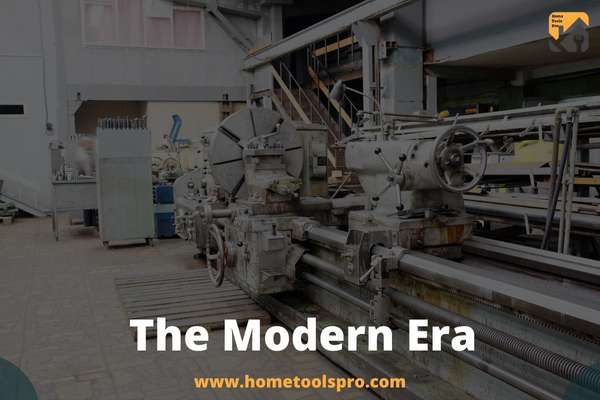History of Lathe, one of the best tools ever invented!

Lathe machines are immensely important tools for manufacturing equipment, and there is a wide range of types available to suit various needs. While the first lathes were likely invented in the ancient world, they didn’t become widespread until the Industrial Revolution.
A lathe is a machine that has been used for centuries to shape wood and metal. The first lathes were probably developed in Egypt and Mesopotamia more than 3000 years ago. In early lathes, the workpiece was held between two posts, one of which was fixed while the other was rotated. The rotation was achieved by manual labour or by animal power.
Gradually, lathes began to be powered by waterwheels and then by windmills. In the late 1700s, steam engines were developed that could provide a constant source of power, leading to the development of the modern lathe.
Today, lathes are used to create a wide variety of objects, from baseball bats to aeroplane engines. They are an essential part of many manufacturing processes.
The Ancient World
Ancient civilizations across the globe relied on this simple gadget, particularly in Assyria and Greece. It became famous for many of the same reasons as today’s modern lathe. The Romans continued to be innovators by inventing the rotating bow, a tool. This device allowed the lathe operator to conduct the turning operation on their own, but it lacked the power and precision of the two-person strap type.
During the Dark Ages following the fall of Rome, very little innovation took place in lathe design or construction. It wasn’t until around 1000 AD that the first wind-powered lathes began to appear in Europe.
The Industrial Revolution

The industrial revolution brought about many changes to the world of manufacturing, including the introduction of powered lathes. Before the industrial revolution, most lathes were powered by waterwheels or windmills.
The first steam-powered lathes were developed in the late 1700s. These new machines allowed for a much higher level of precision and productivity.
As the industrial revolution continued, lathes became increasingly specialized. Different types of lathes were developed to suit the needs of different industries.
The Middle Ages
The lathe progressed at the same pace as the passing of time. Feudal kingdoms that developed after the fall of Rome and the subsequent division of Europe provided as breeding grounds for the pole lathe, the next significant advancement in lathe technology. To free up the worker’s hands, a pedal was used to control this new lathe, which had a minimal learning curve. In spite of their waning popularity in the early twentieth century, this particular type of lathe and its various variations of it remained an essential piece of machinery.
Pre-industrial innovations continued long after the lathe had fallen behind the fast-moving tide of progress. To meet the demands of the American Revolutionary War, the English were able to create high-quality canons using a horse-powered lathe in the 1700s. However, these lathes still had some limits despite all of these developments. Because a single human or horse can only produce a finite amount of power, none of them could be overly intricate, massive, or powerful.
The Renaissance

A brand new variety of lathes that came to be known as the screw-cutting lathe was developed during the Renaissance. The use of this equipment made it possible to create screws with extremely accurate threading. Manufacturing took a significant leap forwards as a result of this development, which enabled the mass production of screws and other threaded products.
You can also echck out the Can You Weld an AiCompressor Tank? here.
Throughout the eighteenth and nineteenth centuries, the screw-cutting lathe underwent a continuous process of development and improvement. A man named John Wilkinson designed a sort of lathe in the year 1841 that was capable of cutting threads in both the metric and imperial systems. Because of this, it became feasible to manufacture screws with any thread size, which was a crucial capability for the quickly expanding industrial and technical sectors.
The Modern Era

The most up-to-date lathes are controlled by computers and have the capability of producing items with a high degree of accuracy. The fundamental construction of the lathe has, for the most part, stayed essentially constant over the course of several centuries, despite the many advancements that have been made in the field.
The development of motorized lathes was undoubtedly one of the most significant contributions that the Industrial Revolution made. These brand-new machines enabled a significantly increased degree of precision as well as productivity.
As the industrial revolution progressed, lathes gradually developed into their modern specialized forms. In order to meet the requirements of a variety of industries, numerous types of lathes have been invented.
The lathe made advancements at a rate that was proportional to the passage of time. Following the collapse of the Roman empire and the subsequent partition of Europe, the feudal kingdoms that emerged served as the incubators for the development of the pole lathe, the subsequent significant step forwards in the evolution of lathe technology. This revolutionary lathe, which required very little training, was controlled by a pedal, which allowed the worker to make better use of both hands. In spite of the fact that their popularity was on the decline at the beginning of the twentieth century, this specific kind of lathe and the many other varieties of it continued to be an essential piece of machinery.
The importance of the Lathe over the centuries
Throughout the course of human history, the lathe has been an indispensable instrument for turning wood, metal, and a variety of other materials. The first lathes were straightforward machines that merely included a support structure, a driving belt, and a cutting tool that rotated on its axis. The lathes of today are much more advanced than those of the past, but the basic concept has not changed: a workpiece is mounted on a spindle and spun at high speed, while a cutting tool is used to create the required shape. Lathes have a wide range of applications, from the production of bowls and vases to the assembly of components for aircraft. A lathe is a truly flexible piece of machinery that has played a significant part in the development of the world in which we live. And even today, it remains one of the best ways to create objects with a high degree of accuracy and precision.



